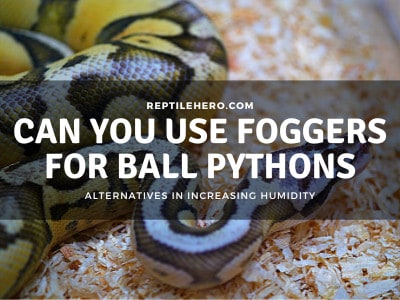How Long Can Ball Pythons Last Underwater? (Will They Drown?)
You probably saw a ball python soaking in a water dish and wondered, how long can they last underwater? Should you be worried that your ball python might drown? Almost every aspect of a ball python’s husbandry has risks, is soaking one of them?
Based on anecdotal evidence, it is estimated that the average ball python can hold its breath for 5–10 minutes when soaking. Some pythons have even been observed to last for up to 20 minutes underwater. If they keep their heads underwater, it is most probably due to shedding and mite issues.
A ball python will soak in its water dish for a number of reasons. Do you need to bathe your ball python? What should you do before proceeding? Continue reading until the end to know more!
How Long Can a Ball Python Safely Stay Underwater?
The safest duration of a ball python staying underwater is estimated at about 5–10 minutes. As long as they can easily get to the surface for air, ball pythons will be safe underwater.
One keeper observed and timed his ball python diving underwater during a bath and she got a time of 10 minutes before the snake came up. Another keeper also shared that her ball python willingly dived underwater in a fish aquarium to swim.
Ball pythons have lower oxygen affinity, meaning they can survive with low oxygen levels for long periods [1]. This is why the average time they can hold their breath is longer compared to some animals and humans.
4 Reasons Why a Ball Python’s Head is Underwater
In general, ball pythons put their heads underwater due to: 1) shedding, 2) mite infestation, 3) thermoregulation, and 4) thirst.
1. Shedding
If a ball python is seen with its head underwater, they are most probably preparing to shed. When going into shed, ball pythons need high humidity and moisture to peel off their old skin easily. That is why they are commonly found soaking in water bowls.
Ball pythons are often found soaking with their heads underwater when they are about to shed.
So do not be alarmed if you find your scaly pet going for a bath. It is normal behavior for ball pythons.
In addition to this, ball pythons also shed from their head first before the body area. This is one of the reasons why they soak their heads underwater.
2. Mite Infestation
Mite infestation is another factor that causes ball pythons to soak their heads underwater. Ball pythons can feel the discomfort and know that they are infested with mites. This urges them to soak in a body of water to drown out the external parasites.
If you see your ball python soaking its head underwater, then there is a probability that mites have infested the head area.

Mites like to wedge themselves in scales or holes/gaps. In the ball python’s head, the pit glands, eyes, and chin are the spots where mites are usually located.
3. Thermoregulation
When ball pythons soak in a water bowl with their heads underwater, it can also mean that they are thermoregulating. Ball pythons are ectotherms which means that they need external factors like ambient temperature and humidity to thermoregulate.
When you see your ball python soaking its head in the water dish, it might be a sign that it is trying to cool off.
If you find your snake soaking its head in the water with no signs of mites or shedding, then I suggest checking the temperature and humidity inside the enclosure.
If it is too cold, it can be a problem for ball pythons since they cannot efficiently produce metabolic heat (heat through movement) unlike some other species in the Pythonidae family [2].
4. Thirst
Thirsty ball pythons tend to drink and soak in a body of water to rehydrate. Some ball pythons have also been found drinking while their heads are submerged under water.
I also caught my ball python, Choco, submerging his head under the water and appearing to be drinking. So do not worry too much if you find them in this scenario, they would not drown themselves for fun you know.
Fun Fact: Ball pythons, like most reptiles, can absorb water through their skin. Some reptiles even develop adaptations to further harvest water for rehydration [3].
Do Ball Pythons Need Baths?
Ball pythons do not need baths regularly. It should only be done as the last resort. Baths are can be a highly stressful situation for them, which is why it is not recommended.
Imagine that you are a reclusive creature and you survive by hiding from predators. Then, a larger creature takes you out of your hiding spot and then placed you in a new environment with water and has no way out. Isn’t this scenario stressful?
If ball pythons are provided with the proper humidity levels and a properly-sized water dish, they never really need baths unless they have mites or injuries.
Instead, ball pythons should be provided the “option” of choosing to soak when they feel the need to.
That is why small drinking cups are discouraged because it only provides the bare minimum for the ball python to thrive. The minimum size of the water bowl must be large enough to accommodate soaking for your ball python.
When Should You Take Your Ball Python for a Bath?
Overall, ball pythons will soak in their water dish if they feel the need to. But they do not need assisted bathing unless they have: 1) injuries, 2) mites, 3) constipation, and 4) stuck shed.
1. Injuries
Ball pythons with injuries can be given a bath of diluted povidone-iodine and water solution. This is a first-aid measure to prevent infections in the wound.
Injuries like cuts, lacerations, thermal burns, bites, and scale removal can easily be infected by bacteria which is why first-aid soaking and veterinary consultation are needed.
When preparing the solution, you should aim for a tea color. This can be achieved in a few drops of povidone-iodine.
Soaking due to this implication is only done as a first-aid measure.
For injuries, ball pythons need to be brought immediately to a veterinarian for assessment and possible prescription of antibiotics.
2. Mites
Bathing a mite-infested ball python removes the ectoparasites using the lubrication provided by water. Soaking will provide a ball python a temporary relief but would not guarantee the death of mites.
Soaking ball pythons through water can be done but it is not as effective as the following methods:
- Soaking using soapy water
- Mite treatment
- Using predatory mites
>>Learn more about mite treatments in our article about why ball pythons rub their face.
3. Constipation
Ball pythons that have a bump on their tail areas due to fecal build-up can be a sign of constipation. Giving a warm bath to constipated ball pythons can help them defecate easier.
If you decided to soak your constipated ball python, I recommend using 80–85°F water and soaking the snake for about 10–15 minutes.
>>Learn more about constipation in our article about why ball python poop smells
Afterward, make sure to give your ball python a properly-sized water bowl in its enclosure and ensure that other husbandry parameters are followed and provided.
Baths must only be done once or twice a week to avoid further stressing them out.
Warning: If your ball python has not defecated after 3–4 sessions of warm baths, it might be suffering from impaction. I suggest bringing it to a veterinarian for assisted waste removal and additional treatments.
4. Stuck Shed
Stuck shed happens when there is not enough moisture while a ball python is removing its old skin. They should only be given a bath when the stuck shed is in their eyecaps or it has accumulated to multiple layers.
Ball pythons with a stuck shed in their eyecaps have unclear vision that can lead to stress and refusal of food. Multiple layers of the residual shed are also uncomfortable to them.
It may even cut off circulation in certain body parts like their tails which could result in necrosis or tissue death.
After giving your ball python a warm bath, you should use a towel and gently wipe your snake dry to remove the stuck skin.
However, if ball pythons only have minor stuck shed, like small patches, I discourage bathing them immediately as it can result in unnecessary stress.
Instead of bathing your ball python, I recommend increasing the ambient humidity (70-80%) on the enclosure when they are about to shed. If you cannot maintain high humidity, providing a humid hide or an additional water dish can sometimes do the trick.
>>Learn more about increasing humidity in our article about using foggers for ball pythons
4 Factors to Consider Before Giving Your Ball Python a Bath
Before giving a bath to a ball python, it is recommended to check the following parameters: 1) temperature, 2) depth, 3) location, and 4) security.
1. Temperature
When bathing ball pythons, the water temperature should be around 80–85°F. Water temperatures lower than 75°F and higher than 90°F can pose risks for a ball python such as thermal shock.
The 80–85°F temperature range is concluded to match the ambient temperature inside the enclosure. Providing a bath temperature within this range can lessen the stress for ball pythons.
They won’t have thermal shocks if the water temperature is around the ambient temperature of their enclosure.
Keep in mind that they will typically be soaking for only10–15 minutes to keep them safe from overheating or getting too cold.
2. Depth
Ball pythons do not need deep water sources to soak and rehydrate. A water dish with a depth of 1–2 inches should be enough for them. Ball pythons are not aquatic animals, so they would not normally choose to swim for leisure.
As a safety measure, the depth should allow them to rest their bellies on the floor while keeping their head to the surface.
Even though ball pythons can dive and hold their breath underwater, this is still not recommended. There are still possible risks like being stuck or failing to get out.
Can Ball Pythons Drown?
Ball pythons cannot breathe underwater, which means that they can drown. Although this is a very rare scenario, most cases typically happen with smaller-sized ball pythons.
One keeper shared that his hatchling ball python drowned in a relatively large water bowl. The bowl he used had tall sides, which lead to the drowning of the ball python.
Pro Tip: For hatchling ball pythons, provide a big but shallow water dish (no more than an inch high).
3. Location
When bathing a ball python, it should only be done in a small space like a plastic bin. Outdoor bodies of water like ponds, pools, lakes, etc. are highly discouraged as a bathing place for ball pythons.
Most outdoor bodies of water, especially stagnant ones, pose risks like parasites, bacteria, and chemicals (like chlorine in pools).
Concerning this, you cannot take your ball python for a bath in a lake or pool and then play with it. The depth of the water plus your presence will cause great stress to a ball python.
Ball pythons will only swim when they want to cross to the other side or if they are forced to when fleeing from a predator. They should not be compared to animals like dogs who you can play with in outdoor bodies of water.
4. Security
Ball pythons that are soaking must be supervised at all times and secured with a lid. They can leave easily from most plastic tubs that they are put into for bathing. Small ventilation holes are also needed for the bin used.
Plastic bins with a clipping lock about 15–20 inches in length and 10 inches in width can be a perfect soaking tub for an adult ball python. Ventilation holes can be placed on top, side, or both, even for a 15-minute bath, it can help with air/ temperature regulation.
During baths, you should never leave a ball python alone to prevent the chances of accidents and escaping. Others share that their ball pythons can push through lids with no lock during baths.
So if they have the chance to escape, ball pythons can climb out of a plastic tub less than 12 inches in height with great ease.
Further Questions
Can ball pythons swim?
Ball pythons can swim like most snakes in the Pythonidae family. They can swim on the surface to flee from predators or to cross a body of water.
Do ball pythons like swimming underwater?
Anecdotal evidence suggests that ball pythons do not like swimming or being in deep waters, in general. This is due to their panicked movements and desperation to get to the shallow or on a solid surface.
Summary of How Long Ball Pythons Last Underwater
Ball pythons are estimated to last underwater for around 5–10 minutes. They can be found submerged underwater due to being in shed, having mites, thermoregulating, and drinking.
Most of the time, ball pythons do not need to bathe. Furthermore, it is not recommended to bathe them unless the snake has injuries, mites, constipation, and stuck shed.
Before giving a bath to a ball python, it is recommended to check whether the water is at the proper temperature and depth. The location of where to bathe the ball python should also be taken into consideration in addition to the proper security.
Resources
[1] https://www.researchgate.net/publication/31442824_Blood_Oxygen_Transport_and_Delivery_in_Reptiles
[2] https://sci-hub.se/https://link.springer.com/article/10.1007/BF00693366
[3] https://sci-hub.se/https://link.springer.com/chapter/10.1007/978-3-319-74144-4_4






